Khaled Boumali: Consultancy Project Experience Reflection Report
VerifiedAdded on 2021/09/01
|13
|4255
|120
Report
AI Summary
This report reflects on Khaled Boumali's consultancy project experience as part of his MSc Management and International Business program at NTU. The report utilizes the Gibbs Reflective Cycle to structure the experience, detailing the project's flow, challenges, and the application of project management methods. It explores teamwork dynamics, leadership values, and cultural diversity factors within the team, highlighting the use of communication tools like Microsoft Teams and WhatsApp. The report also includes a personal development plan and concludes with insights gained throughout the project, offering a comprehensive overview of the practical application of theoretical knowledge in a real-world consultancy setting. The report emphasizes the importance of planning, communication, and team engagement for successful project delivery. The project aimed to assist the client, Hive Thinking, with their national expansion in the UK.
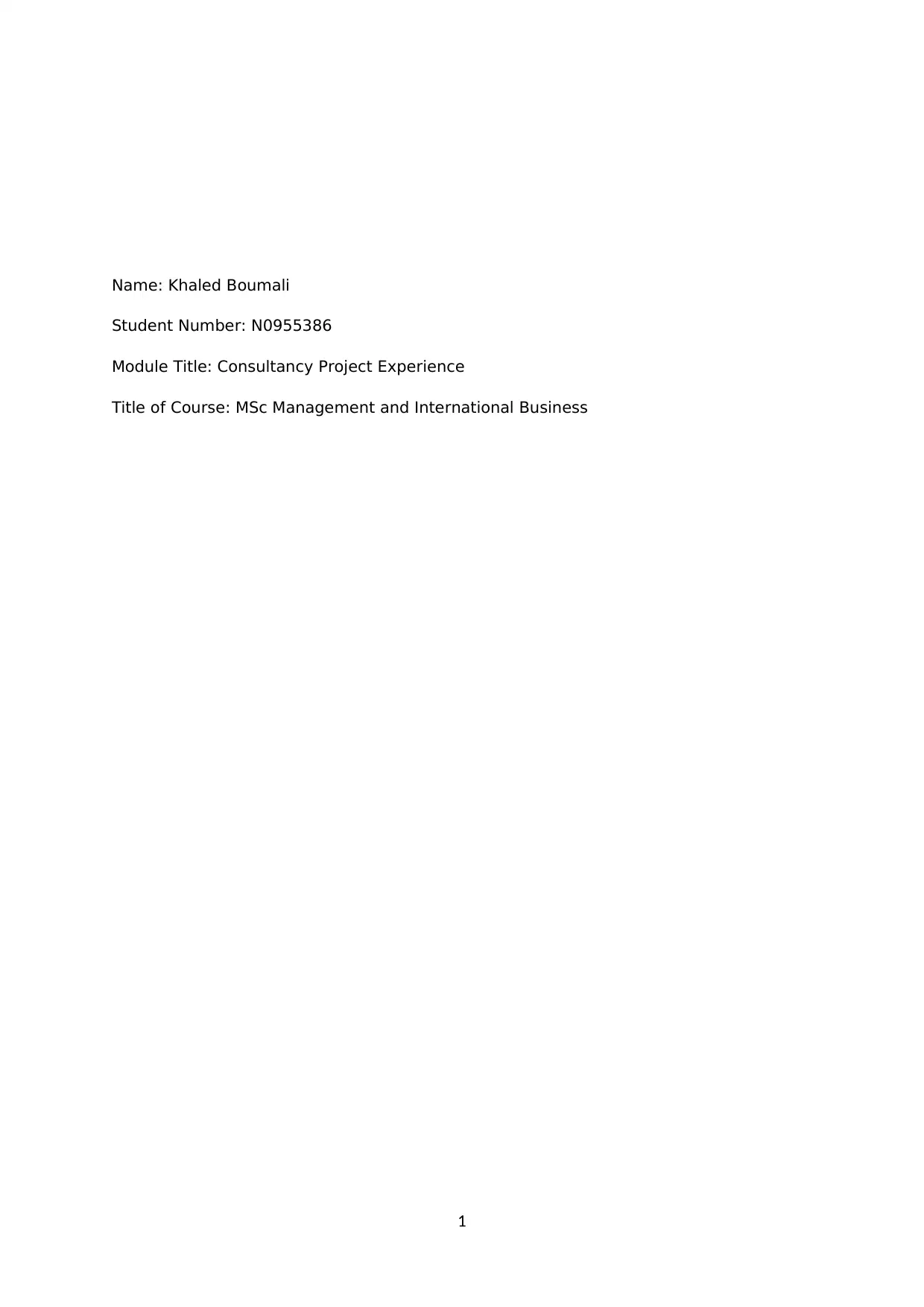
1
Name: Khaled Boumali
Student Number: N0955386
Module Title: Consultancy Project Experience
Title of Course: MSc Management and International Business
Name: Khaled Boumali
Student Number: N0955386
Module Title: Consultancy Project Experience
Title of Course: MSc Management and International Business
Paraphrase This Document
Need a fresh take? Get an instant paraphrase of this document with our AI Paraphraser
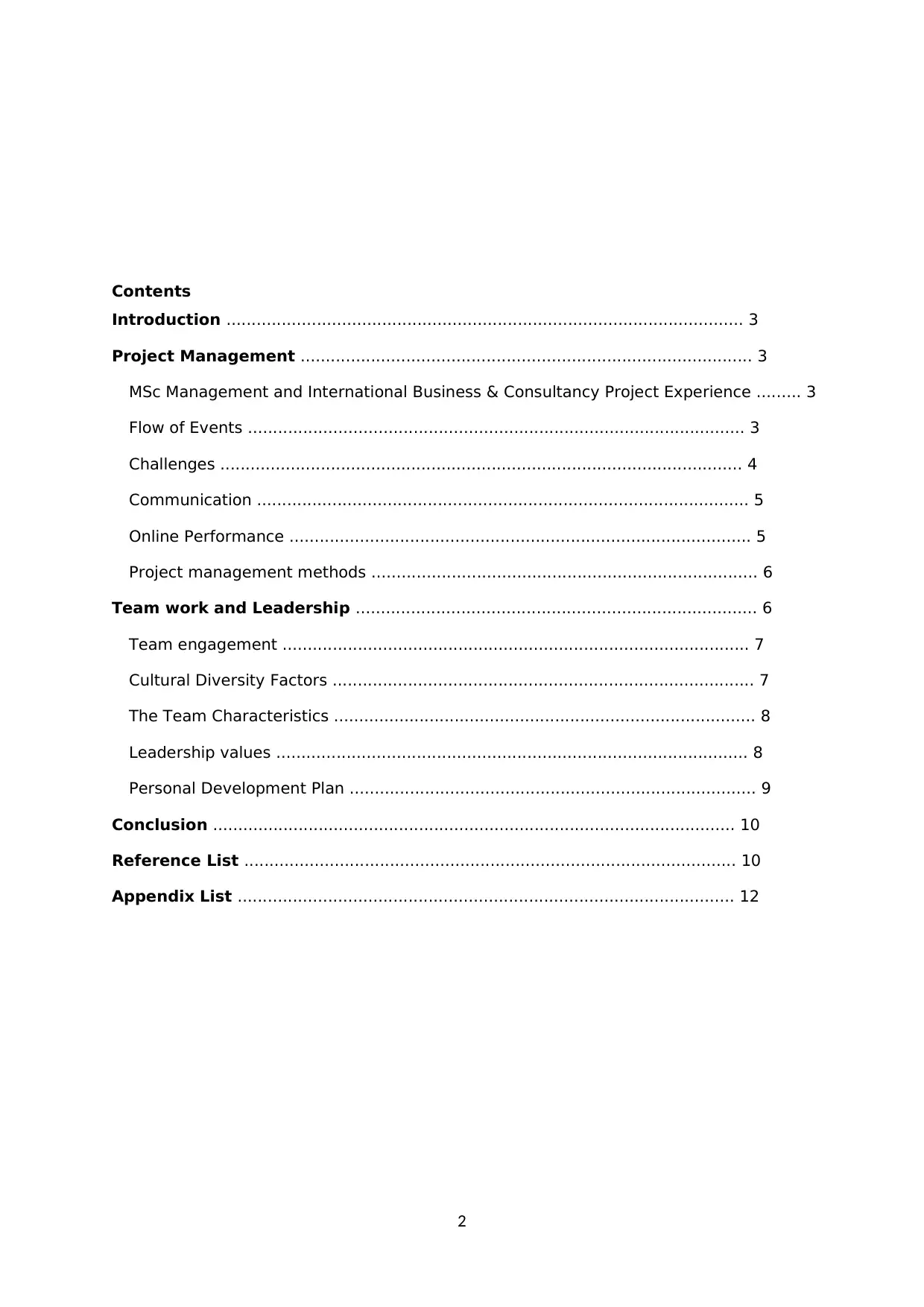
2
Contents
Introduction ....................................................................................................... 3
Project Management .......................................................................................... 3
MSc Management and International Business & Consultancy Project Experience ......... 3
Flow of Events ................................................................................................... 3
Challenges ........................................................................................................ 4
Communication .................................................................................................. 5
Online Performance ............................................................................................ 5
Project management methods ............................................................................. 6
Team work and Leadership ................................................................................ 6
Team engagement ............................................................................................. 7
Cultural Diversity Factors .................................................................................... 7
The Team Characteristics .................................................................................... 8
Leadership values .............................................................................................. 8
Personal Development Plan ................................................................................. 9
Conclusion ........................................................................................................ 10
Reference List .................................................................................................. 10
Appendix List ................................................................................................... 12
Contents
Introduction ....................................................................................................... 3
Project Management .......................................................................................... 3
MSc Management and International Business & Consultancy Project Experience ......... 3
Flow of Events ................................................................................................... 3
Challenges ........................................................................................................ 4
Communication .................................................................................................. 5
Online Performance ............................................................................................ 5
Project management methods ............................................................................. 6
Team work and Leadership ................................................................................ 6
Team engagement ............................................................................................. 7
Cultural Diversity Factors .................................................................................... 7
The Team Characteristics .................................................................................... 8
Leadership values .............................................................................................. 8
Personal Development Plan ................................................................................. 9
Conclusion ........................................................................................................ 10
Reference List .................................................................................................. 10
Appendix List ................................................................................................... 12
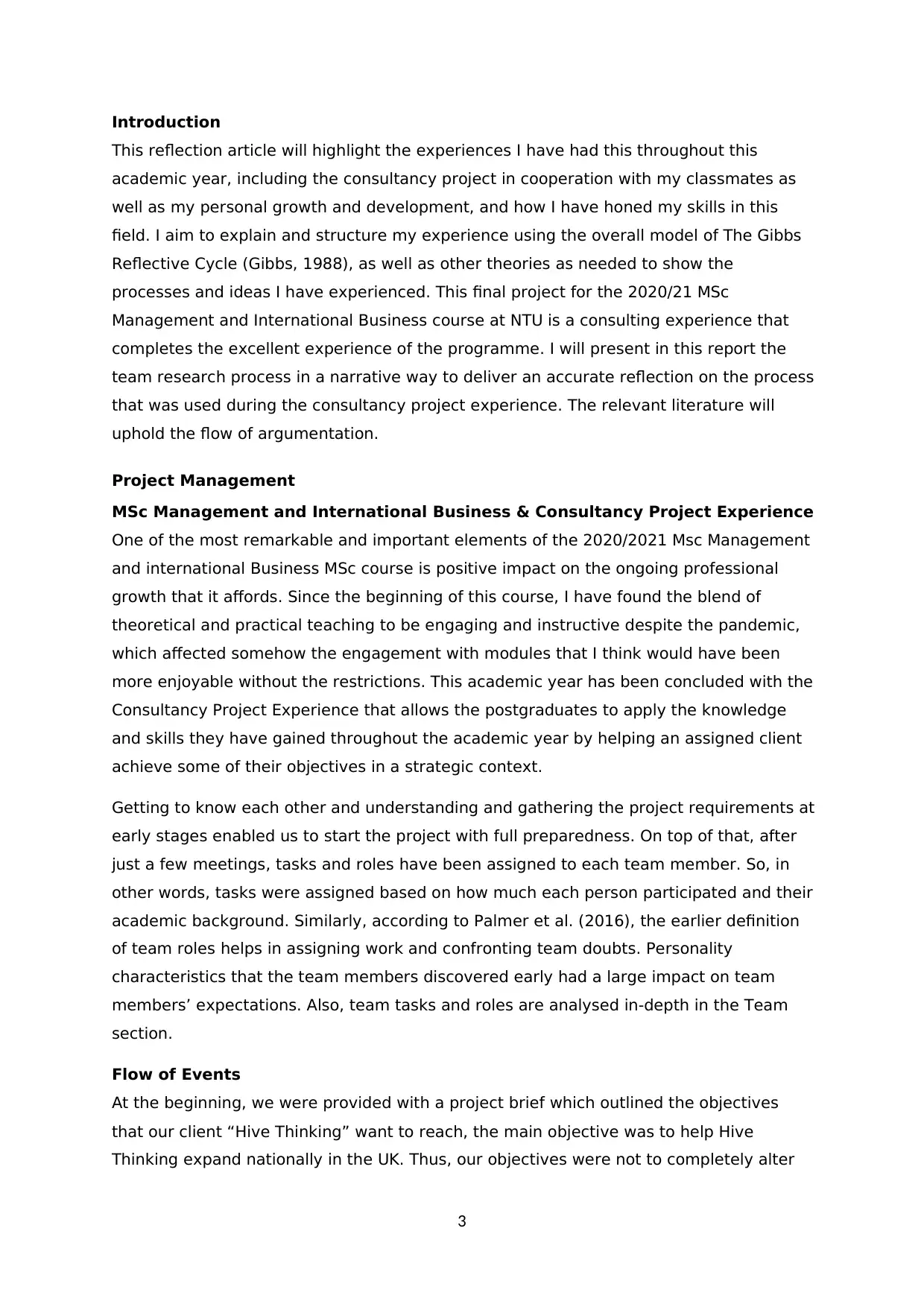
3
Introduction
This reflection article will highlight the experiences I have had this throughout this
academic year, including the consultancy project in cooperation with my classmates as
well as my personal growth and development, and how I have honed my skills in this
field. I aim to explain and structure my experience using the overall model of The Gibbs
Reflective Cycle (Gibbs, 1988), as well as other theories as needed to show the
processes and ideas I have experienced. This final project for the 2020/21 MSc
Management and International Business course at NTU is a consulting experience that
completes the excellent experience of the programme. I will present in this report the
team research process in a narrative way to deliver an accurate reflection on the process
that was used during the consultancy project experience. The relevant literature will
uphold the flow of argumentation.
Project Management
MSc Management and International Business & Consultancy Project Experience
One of the most remarkable and important elements of the 2020/2021 Msc Management
and international Business MSc course is positive impact on the ongoing professional
growth that it affords. Since the beginning of this course, I have found the blend of
theoretical and practical teaching to be engaging and instructive despite the pandemic,
which affected somehow the engagement with modules that I think would have been
more enjoyable without the restrictions. This academic year has been concluded with the
Consultancy Project Experience that allows the postgraduates to apply the knowledge
and skills they have gained throughout the academic year by helping an assigned client
achieve some of their objectives in a strategic context.
Getting to know each other and understanding and gathering the project requirements at
early stages enabled us to start the project with full preparedness. On top of that, after
just a few meetings, tasks and roles have been assigned to each team member. So, in
other words, tasks were assigned based on how much each person participated and their
academic background. Similarly, according to Palmer et al. (2016), the earlier definition
of team roles helps in assigning work and confronting team doubts. Personality
characteristics that the team members discovered early had a large impact on team
members’ expectations. Also, team tasks and roles are analysed in-depth in the Team
section.
Flow of Events
At the beginning, we were provided with a project brief which outlined the objectives
that our client “Hive Thinking” want to reach, the main objective was to help Hive
Thinking expand nationally in the UK. Thus, our objectives were not to completely alter
Introduction
This reflection article will highlight the experiences I have had this throughout this
academic year, including the consultancy project in cooperation with my classmates as
well as my personal growth and development, and how I have honed my skills in this
field. I aim to explain and structure my experience using the overall model of The Gibbs
Reflective Cycle (Gibbs, 1988), as well as other theories as needed to show the
processes and ideas I have experienced. This final project for the 2020/21 MSc
Management and International Business course at NTU is a consulting experience that
completes the excellent experience of the programme. I will present in this report the
team research process in a narrative way to deliver an accurate reflection on the process
that was used during the consultancy project experience. The relevant literature will
uphold the flow of argumentation.
Project Management
MSc Management and International Business & Consultancy Project Experience
One of the most remarkable and important elements of the 2020/2021 Msc Management
and international Business MSc course is positive impact on the ongoing professional
growth that it affords. Since the beginning of this course, I have found the blend of
theoretical and practical teaching to be engaging and instructive despite the pandemic,
which affected somehow the engagement with modules that I think would have been
more enjoyable without the restrictions. This academic year has been concluded with the
Consultancy Project Experience that allows the postgraduates to apply the knowledge
and skills they have gained throughout the academic year by helping an assigned client
achieve some of their objectives in a strategic context.
Getting to know each other and understanding and gathering the project requirements at
early stages enabled us to start the project with full preparedness. On top of that, after
just a few meetings, tasks and roles have been assigned to each team member. So, in
other words, tasks were assigned based on how much each person participated and their
academic background. Similarly, according to Palmer et al. (2016), the earlier definition
of team roles helps in assigning work and confronting team doubts. Personality
characteristics that the team members discovered early had a large impact on team
members’ expectations. Also, team tasks and roles are analysed in-depth in the Team
section.
Flow of Events
At the beginning, we were provided with a project brief which outlined the objectives
that our client “Hive Thinking” want to reach, the main objective was to help Hive
Thinking expand nationally in the UK. Thus, our objectives were not to completely alter
⊘ This is a preview!⊘
Do you want full access?
Subscribe today to unlock all pages.

Trusted by 1+ million students worldwide
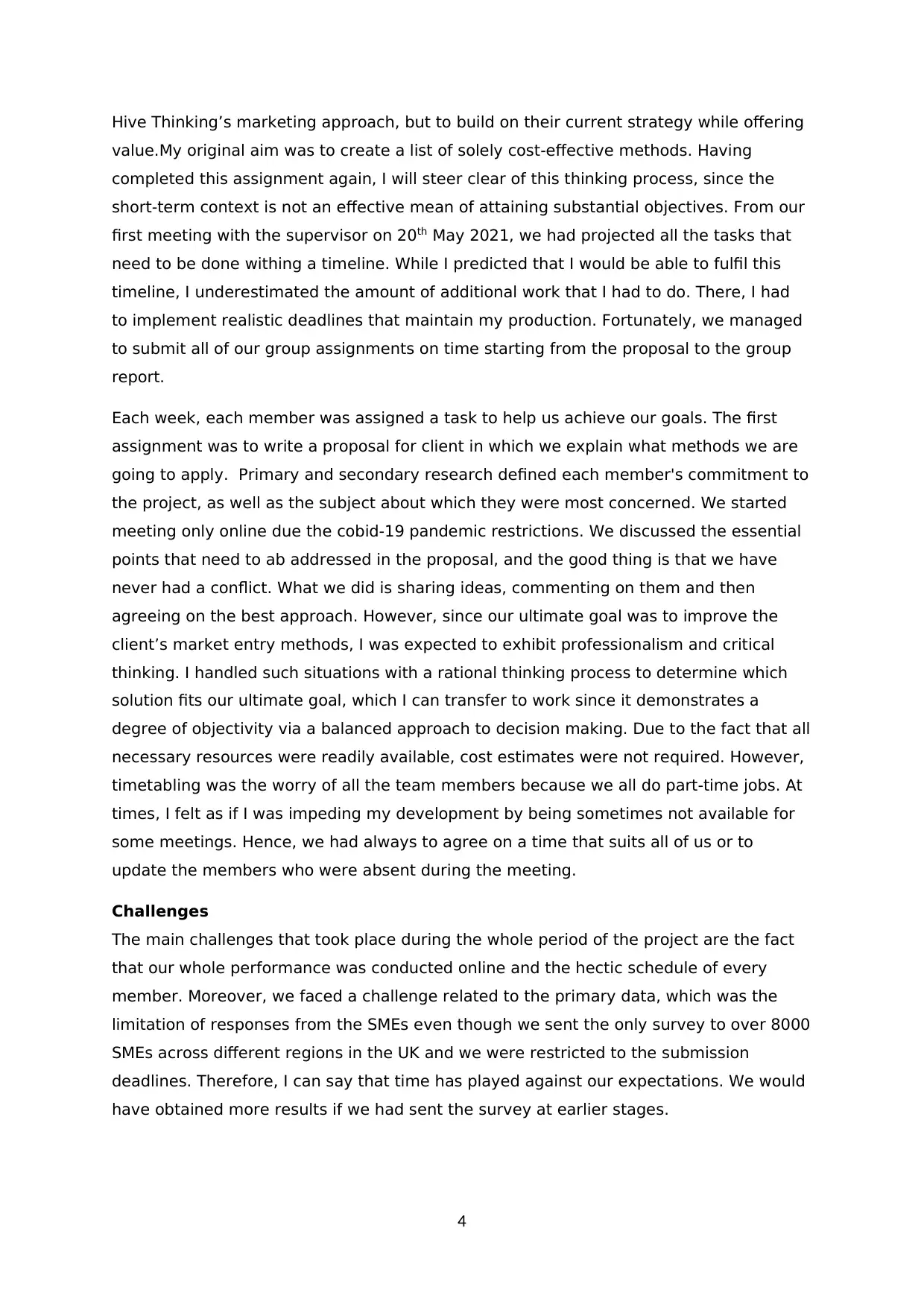
4
Hive Thinking’s marketing approach, but to build on their current strategy while offering
value.My original aim was to create a list of solely cost-effective methods. Having
completed this assignment again, I will steer clear of this thinking process, since the
short-term context is not an effective mean of attaining substantial objectives. From our
first meeting with the supervisor on 20th May 2021, we had projected all the tasks that
need to be done withing a timeline. While I predicted that I would be able to fulfil this
timeline, I underestimated the amount of additional work that I had to do. There, I had
to implement realistic deadlines that maintain my production. Fortunately, we managed
to submit all of our group assignments on time starting from the proposal to the group
report.
Each week, each member was assigned a task to help us achieve our goals. The first
assignment was to write a proposal for client in which we explain what methods we are
going to apply. Primary and secondary research defined each member's commitment to
the project, as well as the subject about which they were most concerned. We started
meeting only online due the cobid-19 pandemic restrictions. We discussed the essential
points that need to ab addressed in the proposal, and the good thing is that we have
never had a conflict. What we did is sharing ideas, commenting on them and then
agreeing on the best approach. However, since our ultimate goal was to improve the
client’s market entry methods, I was expected to exhibit professionalism and critical
thinking. I handled such situations with a rational thinking process to determine which
solution fits our ultimate goal, which I can transfer to work since it demonstrates a
degree of objectivity via a balanced approach to decision making. Due to the fact that all
necessary resources were readily available, cost estimates were not required. However,
timetabling was the worry of all the team members because we all do part-time jobs. At
times, I felt as if I was impeding my development by being sometimes not available for
some meetings. Hence, we had always to agree on a time that suits all of us or to
update the members who were absent during the meeting.
Challenges
The main challenges that took place during the whole period of the project are the fact
that our whole performance was conducted online and the hectic schedule of every
member. Moreover, we faced a challenge related to the primary data, which was the
limitation of responses from the SMEs even though we sent the only survey to over 8000
SMEs across different regions in the UK and we were restricted to the submission
deadlines. Therefore, I can say that time has played against our expectations. We would
have obtained more results if we had sent the survey at earlier stages.
Hive Thinking’s marketing approach, but to build on their current strategy while offering
value.My original aim was to create a list of solely cost-effective methods. Having
completed this assignment again, I will steer clear of this thinking process, since the
short-term context is not an effective mean of attaining substantial objectives. From our
first meeting with the supervisor on 20th May 2021, we had projected all the tasks that
need to be done withing a timeline. While I predicted that I would be able to fulfil this
timeline, I underestimated the amount of additional work that I had to do. There, I had
to implement realistic deadlines that maintain my production. Fortunately, we managed
to submit all of our group assignments on time starting from the proposal to the group
report.
Each week, each member was assigned a task to help us achieve our goals. The first
assignment was to write a proposal for client in which we explain what methods we are
going to apply. Primary and secondary research defined each member's commitment to
the project, as well as the subject about which they were most concerned. We started
meeting only online due the cobid-19 pandemic restrictions. We discussed the essential
points that need to ab addressed in the proposal, and the good thing is that we have
never had a conflict. What we did is sharing ideas, commenting on them and then
agreeing on the best approach. However, since our ultimate goal was to improve the
client’s market entry methods, I was expected to exhibit professionalism and critical
thinking. I handled such situations with a rational thinking process to determine which
solution fits our ultimate goal, which I can transfer to work since it demonstrates a
degree of objectivity via a balanced approach to decision making. Due to the fact that all
necessary resources were readily available, cost estimates were not required. However,
timetabling was the worry of all the team members because we all do part-time jobs. At
times, I felt as if I was impeding my development by being sometimes not available for
some meetings. Hence, we had always to agree on a time that suits all of us or to
update the members who were absent during the meeting.
Challenges
The main challenges that took place during the whole period of the project are the fact
that our whole performance was conducted online and the hectic schedule of every
member. Moreover, we faced a challenge related to the primary data, which was the
limitation of responses from the SMEs even though we sent the only survey to over 8000
SMEs across different regions in the UK and we were restricted to the submission
deadlines. Therefore, I can say that time has played against our expectations. We would
have obtained more results if we had sent the survey at earlier stages.
Paraphrase This Document
Need a fresh take? Get an instant paraphrase of this document with our AI Paraphraser
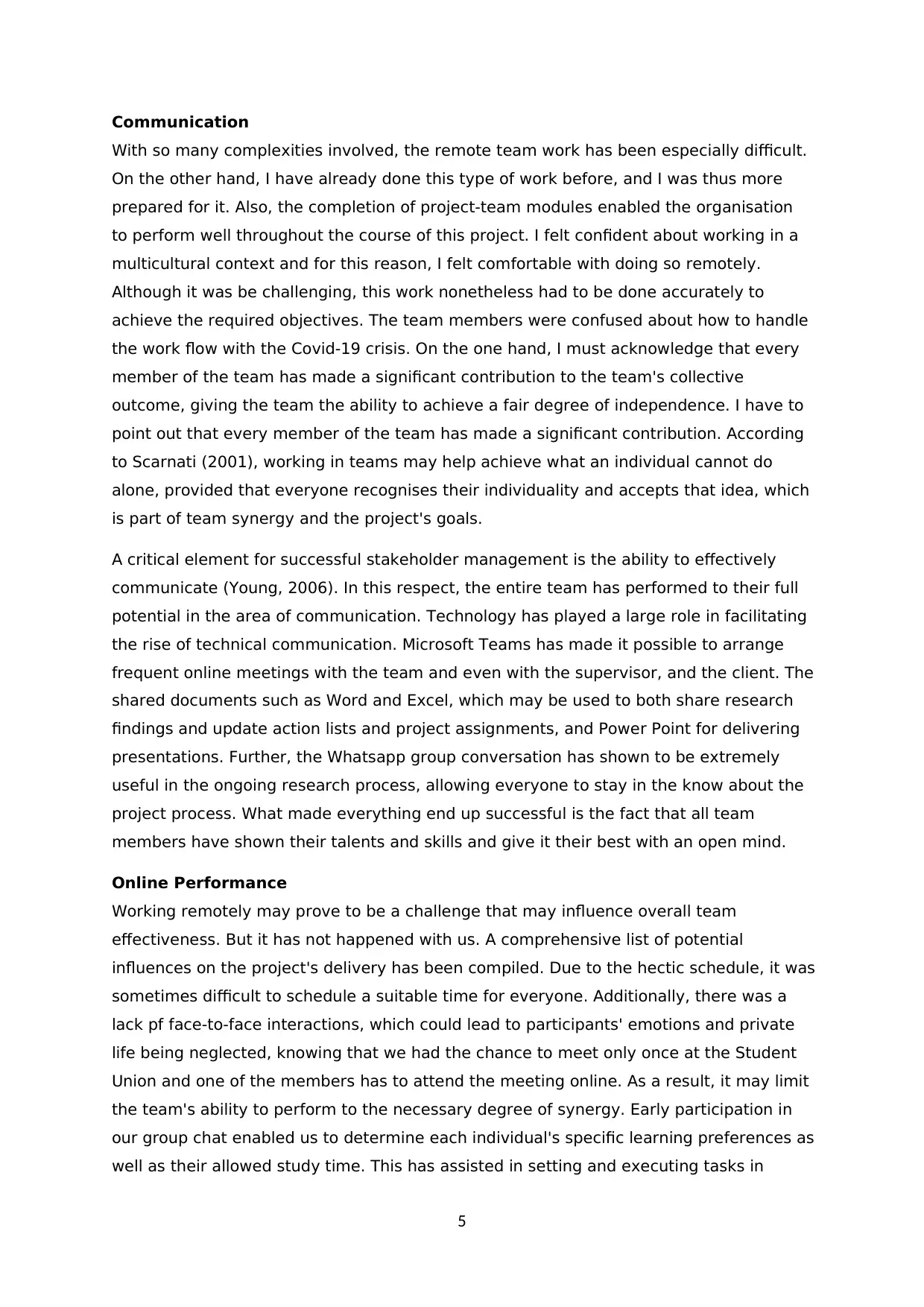
5
Communication
With so many complexities involved, the remote team work has been especially difficult.
On the other hand, I have already done this type of work before, and I was thus more
prepared for it. Also, the completion of project-team modules enabled the organisation
to perform well throughout the course of this project. I felt confident about working in a
multicultural context and for this reason, I felt comfortable with doing so remotely.
Although it was be challenging, this work nonetheless had to be done accurately to
achieve the required objectives. The team members were confused about how to handle
the work flow with the Covid-19 crisis. On the one hand, I must acknowledge that every
member of the team has made a significant contribution to the team's collective
outcome, giving the team the ability to achieve a fair degree of independence. I have to
point out that every member of the team has made a significant contribution. According
to Scarnati (2001), working in teams may help achieve what an individual cannot do
alone, provided that everyone recognises their individuality and accepts that idea, which
is part of team synergy and the project's goals.
A critical element for successful stakeholder management is the ability to effectively
communicate (Young, 2006). In this respect, the entire team has performed to their full
potential in the area of communication. Technology has played a large role in facilitating
the rise of technical communication. Microsoft Teams has made it possible to arrange
frequent online meetings with the team and even with the supervisor, and the client. The
shared documents such as Word and Excel, which may be used to both share research
findings and update action lists and project assignments, and Power Point for delivering
presentations. Further, the Whatsapp group conversation has shown to be extremely
useful in the ongoing research process, allowing everyone to stay in the know about the
project process. What made everything end up successful is the fact that all team
members have shown their talents and skills and give it their best with an open mind.
Online Performance
Working remotely may prove to be a challenge that may influence overall team
effectiveness. But it has not happened with us. A comprehensive list of potential
influences on the project's delivery has been compiled. Due to the hectic schedule, it was
sometimes difficult to schedule a suitable time for everyone. Additionally, there was a
lack pf face-to-face interactions, which could lead to participants' emotions and private
life being neglected, knowing that we had the chance to meet only once at the Student
Union and one of the members has to attend the meeting online. As a result, it may limit
the team's ability to perform to the necessary degree of synergy. Early participation in
our group chat enabled us to determine each individual's specific learning preferences as
well as their allowed study time. This has assisted in setting and executing tasks in
Communication
With so many complexities involved, the remote team work has been especially difficult.
On the other hand, I have already done this type of work before, and I was thus more
prepared for it. Also, the completion of project-team modules enabled the organisation
to perform well throughout the course of this project. I felt confident about working in a
multicultural context and for this reason, I felt comfortable with doing so remotely.
Although it was be challenging, this work nonetheless had to be done accurately to
achieve the required objectives. The team members were confused about how to handle
the work flow with the Covid-19 crisis. On the one hand, I must acknowledge that every
member of the team has made a significant contribution to the team's collective
outcome, giving the team the ability to achieve a fair degree of independence. I have to
point out that every member of the team has made a significant contribution. According
to Scarnati (2001), working in teams may help achieve what an individual cannot do
alone, provided that everyone recognises their individuality and accepts that idea, which
is part of team synergy and the project's goals.
A critical element for successful stakeholder management is the ability to effectively
communicate (Young, 2006). In this respect, the entire team has performed to their full
potential in the area of communication. Technology has played a large role in facilitating
the rise of technical communication. Microsoft Teams has made it possible to arrange
frequent online meetings with the team and even with the supervisor, and the client. The
shared documents such as Word and Excel, which may be used to both share research
findings and update action lists and project assignments, and Power Point for delivering
presentations. Further, the Whatsapp group conversation has shown to be extremely
useful in the ongoing research process, allowing everyone to stay in the know about the
project process. What made everything end up successful is the fact that all team
members have shown their talents and skills and give it their best with an open mind.
Online Performance
Working remotely may prove to be a challenge that may influence overall team
effectiveness. But it has not happened with us. A comprehensive list of potential
influences on the project's delivery has been compiled. Due to the hectic schedule, it was
sometimes difficult to schedule a suitable time for everyone. Additionally, there was a
lack pf face-to-face interactions, which could lead to participants' emotions and private
life being neglected, knowing that we had the chance to meet only once at the Student
Union and one of the members has to attend the meeting online. As a result, it may limit
the team's ability to perform to the necessary degree of synergy. Early participation in
our group chat enabled us to determine each individual's specific learning preferences as
well as their allowed study time. This has assisted in setting and executing tasks in
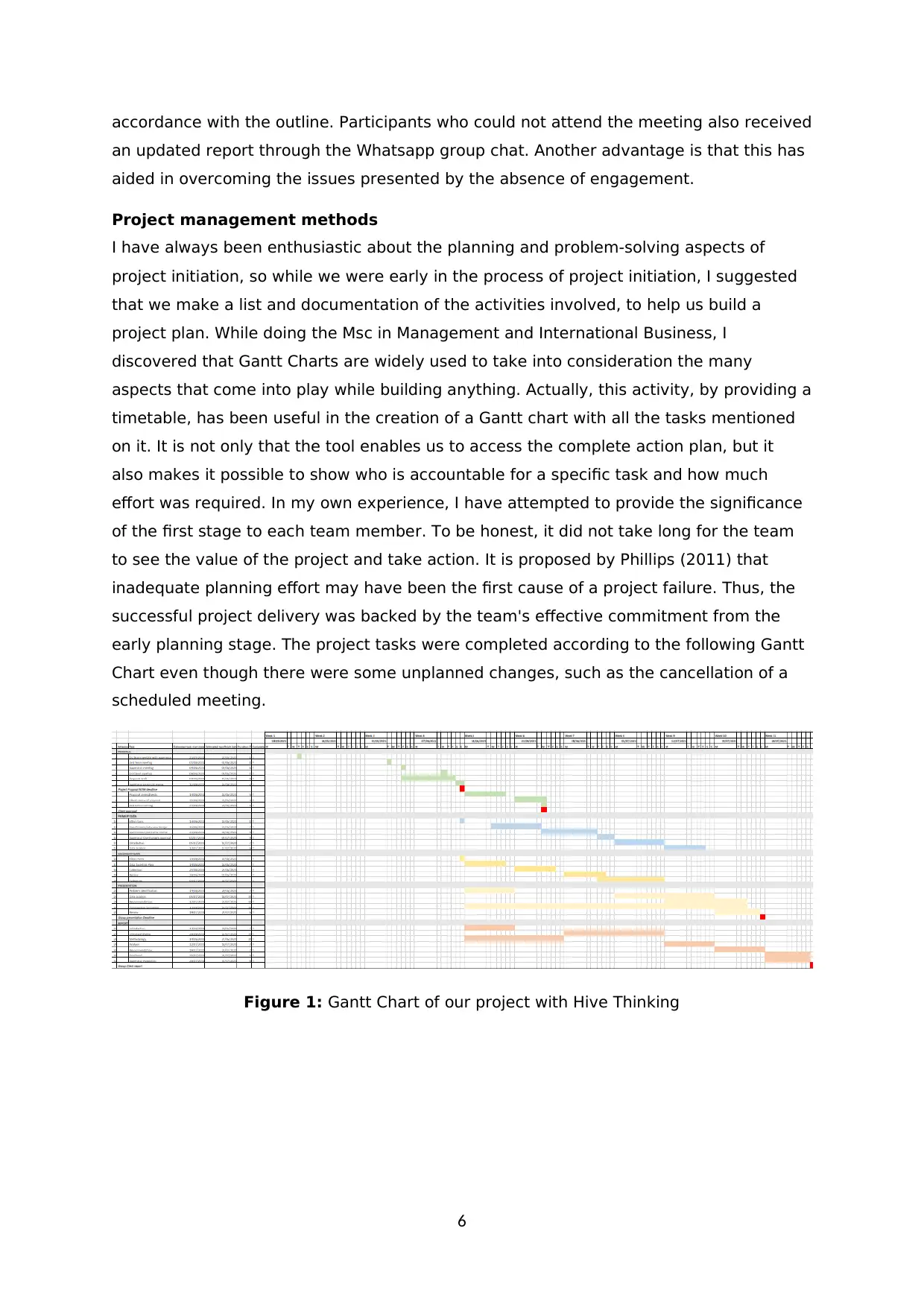
6
accordance with the outline. Participants who could not attend the meeting also received
an updated report through the Whatsapp group chat. Another advantage is that this has
aided in overcoming the issues presented by the absence of engagement.
Project management methods
I have always been enthusiastic about the planning and problem-solving aspects of
project initiation, so while we were early in the process of project initiation, I suggested
that we make a list and documentation of the activities involved, to help us build a
project plan. While doing the Msc in Management and International Business, I
discovered that Gantt Charts are widely used to take into consideration the many
aspects that come into play while building anything. Actually, this activity, by providing a
timetable, has been useful in the creation of a Gantt chart with all the tasks mentioned
on it. It is not only that the tool enables us to access the complete action plan, but it
also makes it possible to show who is accountable for a specific task and how much
effort was required. In my own experience, I have attempted to provide the significance
of the first stage to each team member. To be honest, it did not take long for the team
to see the value of the project and take action. It is proposed by Phillips (2011) that
inadequate planning effort may have been the first cause of a project failure. Thus, the
successful project delivery was backed by the team's effective commitment from the
early planning stage. The project tasks were completed according to the following Gantt
Chart even though there were some unplanned changes, such as the cancellation of a
scheduled meeting.
Figure 1: Gantt Chart of our project with Hive Thinking
accordance with the outline. Participants who could not attend the meeting also received
an updated report through the Whatsapp group chat. Another advantage is that this has
aided in overcoming the issues presented by the absence of engagement.
Project management methods
I have always been enthusiastic about the planning and problem-solving aspects of
project initiation, so while we were early in the process of project initiation, I suggested
that we make a list and documentation of the activities involved, to help us build a
project plan. While doing the Msc in Management and International Business, I
discovered that Gantt Charts are widely used to take into consideration the many
aspects that come into play while building anything. Actually, this activity, by providing a
timetable, has been useful in the creation of a Gantt chart with all the tasks mentioned
on it. It is not only that the tool enables us to access the complete action plan, but it
also makes it possible to show who is accountable for a specific task and how much
effort was required. In my own experience, I have attempted to provide the significance
of the first stage to each team member. To be honest, it did not take long for the team
to see the value of the project and take action. It is proposed by Phillips (2011) that
inadequate planning effort may have been the first cause of a project failure. Thus, the
successful project delivery was backed by the team's effective commitment from the
early planning stage. The project tasks were completed according to the following Gantt
Chart even though there were some unplanned changes, such as the cancellation of a
scheduled meeting.
Figure 1: Gantt Chart of our project with Hive Thinking
⊘ This is a preview!⊘
Do you want full access?
Subscribe today to unlock all pages.

Trusted by 1+ million students worldwide
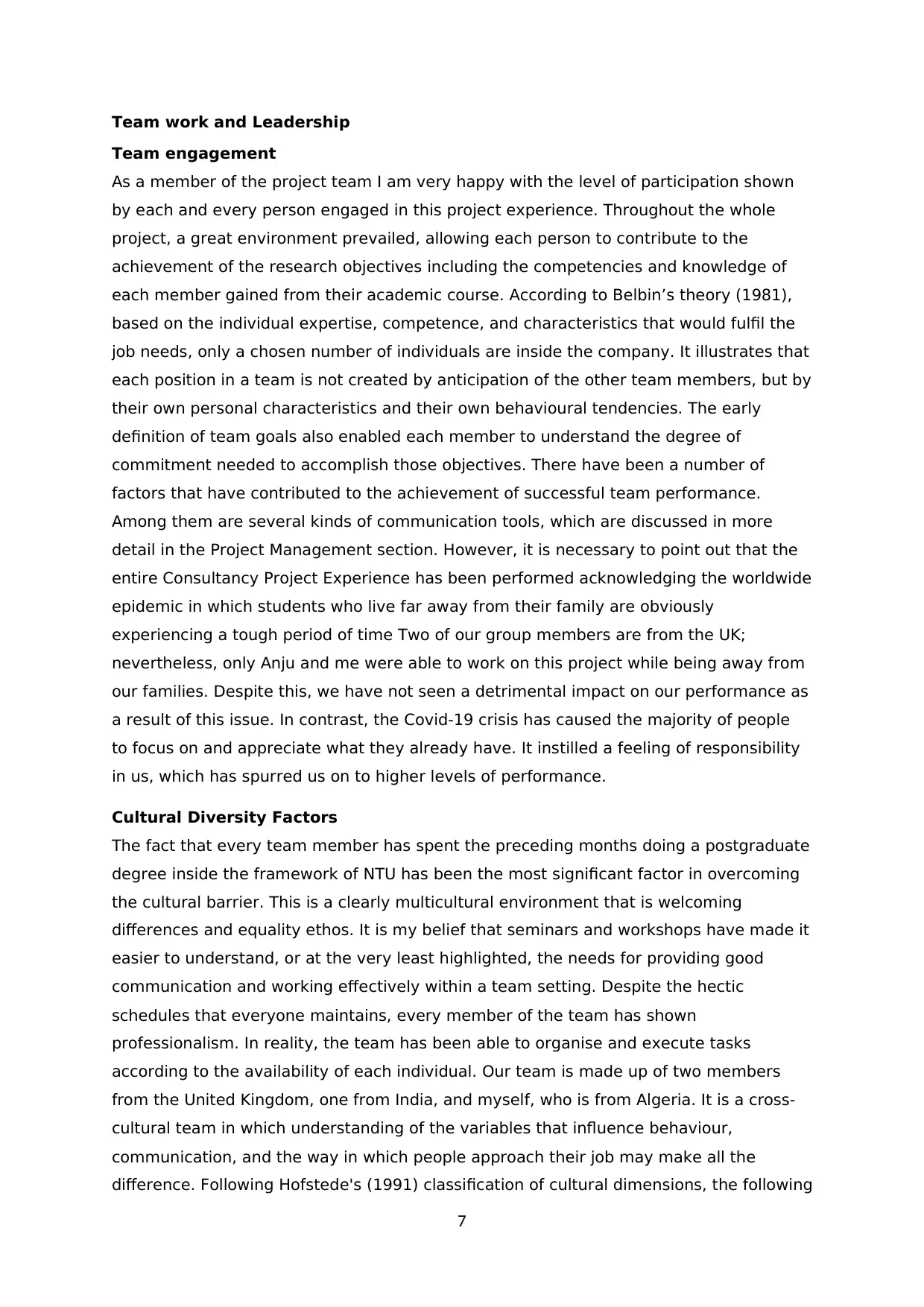
7
Team work and Leadership
Team engagement
As a member of the project team I am very happy with the level of participation shown
by each and every person engaged in this project experience. Throughout the whole
project, a great environment prevailed, allowing each person to contribute to the
achievement of the research objectives including the competencies and knowledge of
each member gained from their academic course. According to Belbin’s theory (1981),
based on the individual expertise, competence, and characteristics that would fulfil the
job needs, only a chosen number of individuals are inside the company. It illustrates that
each position in a team is not created by anticipation of the other team members, but by
their own personal characteristics and their own behavioural tendencies. The early
definition of team goals also enabled each member to understand the degree of
commitment needed to accomplish those objectives. There have been a number of
factors that have contributed to the achievement of successful team performance.
Among them are several kinds of communication tools, which are discussed in more
detail in the Project Management section. However, it is necessary to point out that the
entire Consultancy Project Experience has been performed acknowledging the worldwide
epidemic in which students who live far away from their family are obviously
experiencing a tough period of time Two of our group members are from the UK;
nevertheless, only Anju and me were able to work on this project while being away from
our families. Despite this, we have not seen a detrimental impact on our performance as
a result of this issue. In contrast, the Covid-19 crisis has caused the majority of people
to focus on and appreciate what they already have. It instilled a feeling of responsibility
in us, which has spurred us on to higher levels of performance.
Cultural Diversity Factors
The fact that every team member has spent the preceding months doing a postgraduate
degree inside the framework of NTU has been the most significant factor in overcoming
the cultural barrier. This is a clearly multicultural environment that is welcoming
differences and equality ethos. It is my belief that seminars and workshops have made it
easier to understand, or at the very least highlighted, the needs for providing good
communication and working effectively within a team setting. Despite the hectic
schedules that everyone maintains, every member of the team has shown
professionalism. In reality, the team has been able to organise and execute tasks
according to the availability of each individual. Our team is made up of two members
from the United Kingdom, one from India, and myself, who is from Algeria. It is a cross-
cultural team in which understanding of the variables that influence behaviour,
communication, and the way in which people approach their job may make all the
difference. Following Hofstede's (1991) classification of cultural dimensions, the following
Team work and Leadership
Team engagement
As a member of the project team I am very happy with the level of participation shown
by each and every person engaged in this project experience. Throughout the whole
project, a great environment prevailed, allowing each person to contribute to the
achievement of the research objectives including the competencies and knowledge of
each member gained from their academic course. According to Belbin’s theory (1981),
based on the individual expertise, competence, and characteristics that would fulfil the
job needs, only a chosen number of individuals are inside the company. It illustrates that
each position in a team is not created by anticipation of the other team members, but by
their own personal characteristics and their own behavioural tendencies. The early
definition of team goals also enabled each member to understand the degree of
commitment needed to accomplish those objectives. There have been a number of
factors that have contributed to the achievement of successful team performance.
Among them are several kinds of communication tools, which are discussed in more
detail in the Project Management section. However, it is necessary to point out that the
entire Consultancy Project Experience has been performed acknowledging the worldwide
epidemic in which students who live far away from their family are obviously
experiencing a tough period of time Two of our group members are from the UK;
nevertheless, only Anju and me were able to work on this project while being away from
our families. Despite this, we have not seen a detrimental impact on our performance as
a result of this issue. In contrast, the Covid-19 crisis has caused the majority of people
to focus on and appreciate what they already have. It instilled a feeling of responsibility
in us, which has spurred us on to higher levels of performance.
Cultural Diversity Factors
The fact that every team member has spent the preceding months doing a postgraduate
degree inside the framework of NTU has been the most significant factor in overcoming
the cultural barrier. This is a clearly multicultural environment that is welcoming
differences and equality ethos. It is my belief that seminars and workshops have made it
easier to understand, or at the very least highlighted, the needs for providing good
communication and working effectively within a team setting. Despite the hectic
schedules that everyone maintains, every member of the team has shown
professionalism. In reality, the team has been able to organise and execute tasks
according to the availability of each individual. Our team is made up of two members
from the United Kingdom, one from India, and myself, who is from Algeria. It is a cross-
cultural team in which understanding of the variables that influence behaviour,
communication, and the way in which people approach their job may make all the
difference. Following Hofstede's (1991) classification of cultural dimensions, the following
Paraphrase This Document
Need a fresh take? Get an instant paraphrase of this document with our AI Paraphraser
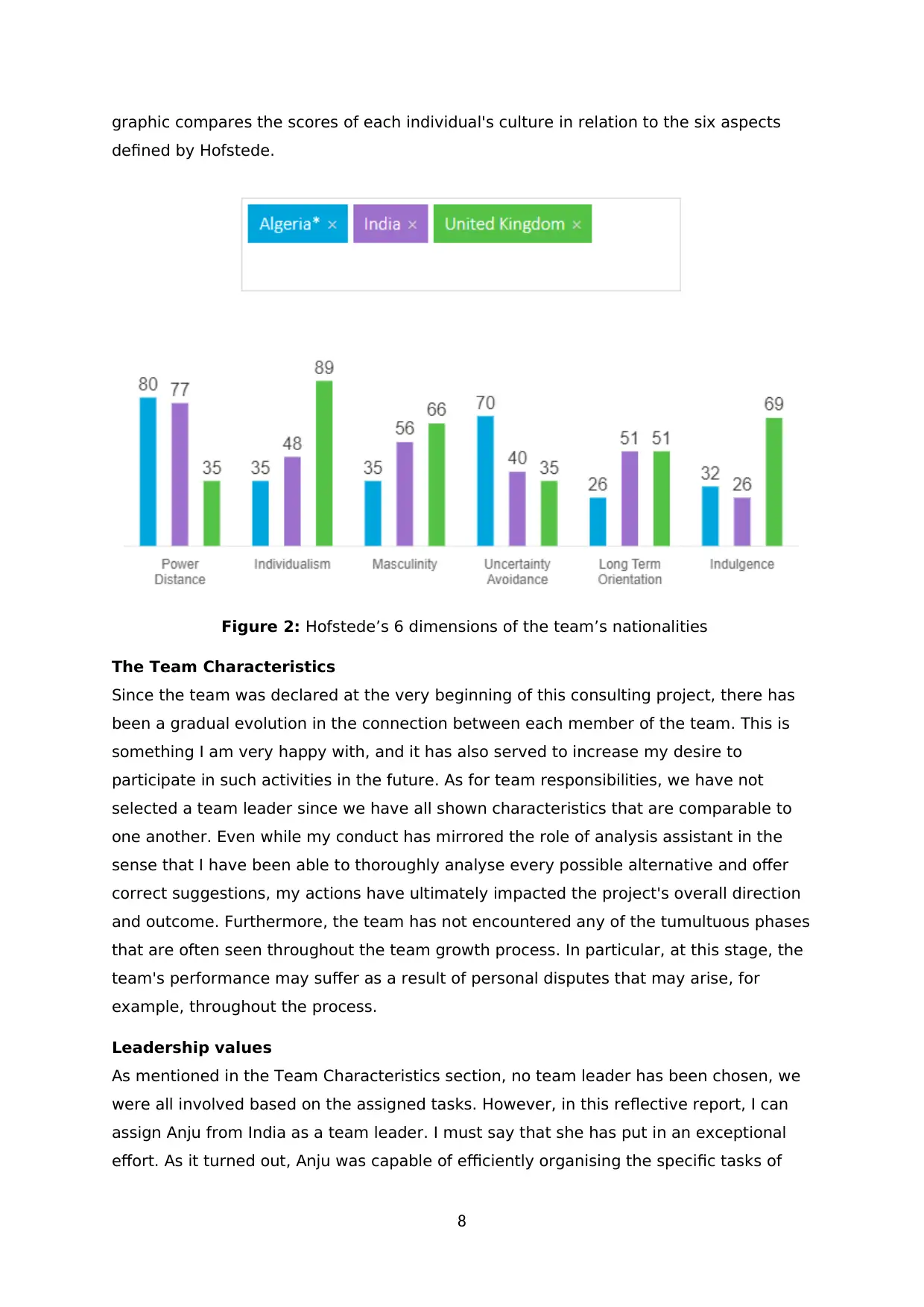
8
graphic compares the scores of each individual's culture in relation to the six aspects
defined by Hofstede.
Figure 2: Hofstede’s 6 dimensions of the team’s nationalities
The Team Characteristics
Since the team was declared at the very beginning of this consulting project, there has
been a gradual evolution in the connection between each member of the team. This is
something I am very happy with, and it has also served to increase my desire to
participate in such activities in the future. As for team responsibilities, we have not
selected a team leader since we have all shown characteristics that are comparable to
one another. Even while my conduct has mirrored the role of analysis assistant in the
sense that I have been able to thoroughly analyse every possible alternative and offer
correct suggestions, my actions have ultimately impacted the project's overall direction
and outcome. Furthermore, the team has not encountered any of the tumultuous phases
that are often seen throughout the team growth process. In particular, at this stage, the
team's performance may suffer as a result of personal disputes that may arise, for
example, throughout the process.
Leadership values
As mentioned in the Team Characteristics section, no team leader has been chosen, we
were all involved based on the assigned tasks. However, in this reflective report, I can
assign Anju from India as a team leader. I must say that she has put in an exceptional
effort. As it turned out, Anju was capable of efficiently organising the specific tasks of
graphic compares the scores of each individual's culture in relation to the six aspects
defined by Hofstede.
Figure 2: Hofstede’s 6 dimensions of the team’s nationalities
The Team Characteristics
Since the team was declared at the very beginning of this consulting project, there has
been a gradual evolution in the connection between each member of the team. This is
something I am very happy with, and it has also served to increase my desire to
participate in such activities in the future. As for team responsibilities, we have not
selected a team leader since we have all shown characteristics that are comparable to
one another. Even while my conduct has mirrored the role of analysis assistant in the
sense that I have been able to thoroughly analyse every possible alternative and offer
correct suggestions, my actions have ultimately impacted the project's overall direction
and outcome. Furthermore, the team has not encountered any of the tumultuous phases
that are often seen throughout the team growth process. In particular, at this stage, the
team's performance may suffer as a result of personal disputes that may arise, for
example, throughout the process.
Leadership values
As mentioned in the Team Characteristics section, no team leader has been chosen, we
were all involved based on the assigned tasks. However, in this reflective report, I can
assign Anju from India as a team leader. I must say that she has put in an exceptional
effort. As it turned out, Anju was capable of efficiently organising the specific tasks of
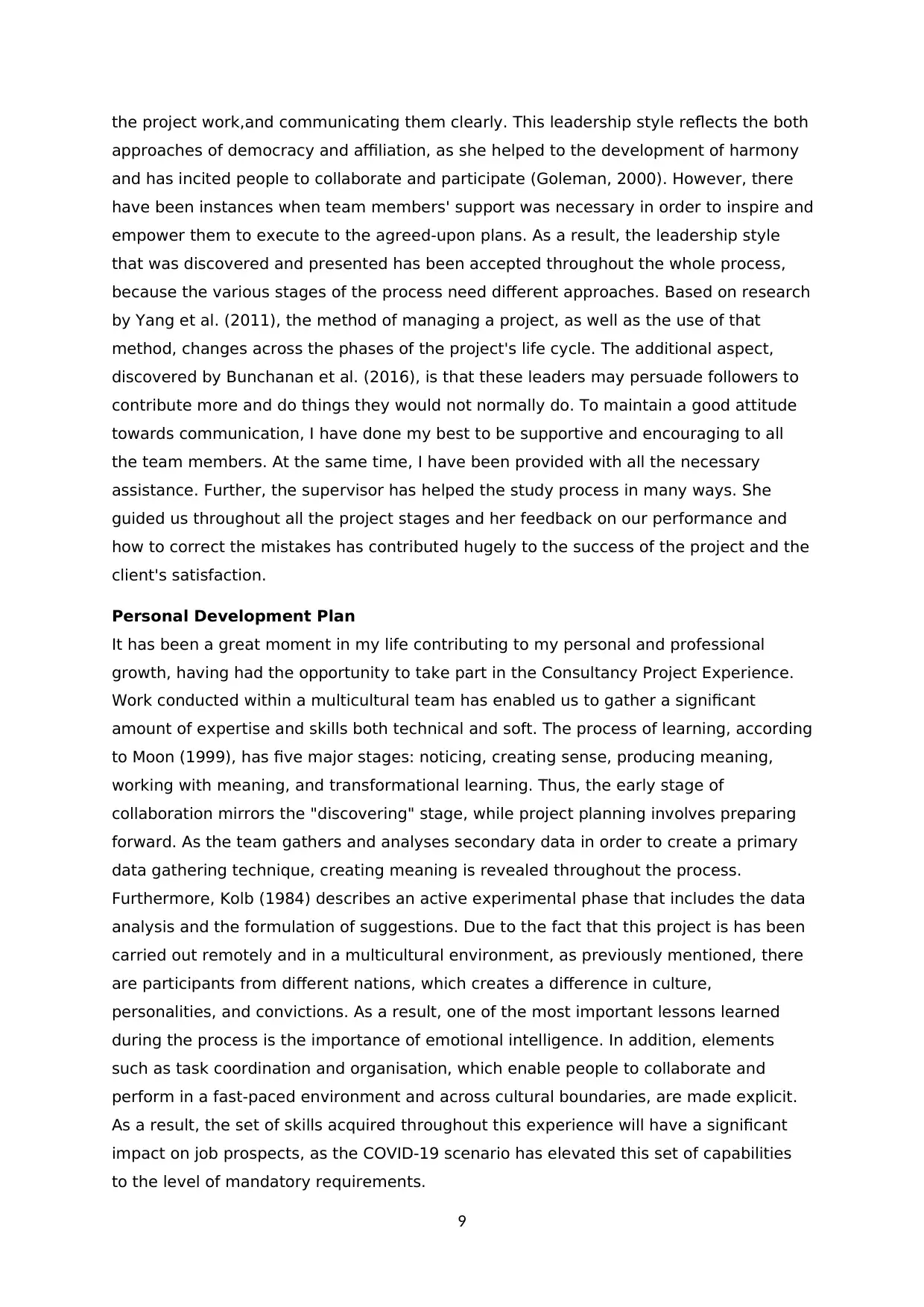
9
the project work,and communicating them clearly. This leadership style reflects the both
approaches of democracy and affiliation, as she helped to the development of harmony
and has incited people to collaborate and participate (Goleman, 2000). However, there
have been instances when team members' support was necessary in order to inspire and
empower them to execute to the agreed-upon plans. As a result, the leadership style
that was discovered and presented has been accepted throughout the whole process,
because the various stages of the process need different approaches. Based on research
by Yang et al. (2011), the method of managing a project, as well as the use of that
method, changes across the phases of the project's life cycle. The additional aspect,
discovered by Bunchanan et al. (2016), is that these leaders may persuade followers to
contribute more and do things they would not normally do. To maintain a good attitude
towards communication, I have done my best to be supportive and encouraging to all
the team members. At the same time, I have been provided with all the necessary
assistance. Further, the supervisor has helped the study process in many ways. She
guided us throughout all the project stages and her feedback on our performance and
how to correct the mistakes has contributed hugely to the success of the project and the
client's satisfaction.
Personal Development Plan
It has been a great moment in my life contributing to my personal and professional
growth, having had the opportunity to take part in the Consultancy Project Experience.
Work conducted within a multicultural team has enabled us to gather a significant
amount of expertise and skills both technical and soft. The process of learning, according
to Moon (1999), has five major stages: noticing, creating sense, producing meaning,
working with meaning, and transformational learning. Thus, the early stage of
collaboration mirrors the "discovering" stage, while project planning involves preparing
forward. As the team gathers and analyses secondary data in order to create a primary
data gathering technique, creating meaning is revealed throughout the process.
Furthermore, Kolb (1984) describes an active experimental phase that includes the data
analysis and the formulation of suggestions. Due to the fact that this project is has been
carried out remotely and in a multicultural environment, as previously mentioned, there
are participants from different nations, which creates a difference in culture,
personalities, and convictions. As a result, one of the most important lessons learned
during the process is the importance of emotional intelligence. In addition, elements
such as task coordination and organisation, which enable people to collaborate and
perform in a fast-paced environment and across cultural boundaries, are made explicit.
As a result, the set of skills acquired throughout this experience will have a significant
impact on job prospects, as the COVID-19 scenario has elevated this set of capabilities
to the level of mandatory requirements.
the project work,and communicating them clearly. This leadership style reflects the both
approaches of democracy and affiliation, as she helped to the development of harmony
and has incited people to collaborate and participate (Goleman, 2000). However, there
have been instances when team members' support was necessary in order to inspire and
empower them to execute to the agreed-upon plans. As a result, the leadership style
that was discovered and presented has been accepted throughout the whole process,
because the various stages of the process need different approaches. Based on research
by Yang et al. (2011), the method of managing a project, as well as the use of that
method, changes across the phases of the project's life cycle. The additional aspect,
discovered by Bunchanan et al. (2016), is that these leaders may persuade followers to
contribute more and do things they would not normally do. To maintain a good attitude
towards communication, I have done my best to be supportive and encouraging to all
the team members. At the same time, I have been provided with all the necessary
assistance. Further, the supervisor has helped the study process in many ways. She
guided us throughout all the project stages and her feedback on our performance and
how to correct the mistakes has contributed hugely to the success of the project and the
client's satisfaction.
Personal Development Plan
It has been a great moment in my life contributing to my personal and professional
growth, having had the opportunity to take part in the Consultancy Project Experience.
Work conducted within a multicultural team has enabled us to gather a significant
amount of expertise and skills both technical and soft. The process of learning, according
to Moon (1999), has five major stages: noticing, creating sense, producing meaning,
working with meaning, and transformational learning. Thus, the early stage of
collaboration mirrors the "discovering" stage, while project planning involves preparing
forward. As the team gathers and analyses secondary data in order to create a primary
data gathering technique, creating meaning is revealed throughout the process.
Furthermore, Kolb (1984) describes an active experimental phase that includes the data
analysis and the formulation of suggestions. Due to the fact that this project is has been
carried out remotely and in a multicultural environment, as previously mentioned, there
are participants from different nations, which creates a difference in culture,
personalities, and convictions. As a result, one of the most important lessons learned
during the process is the importance of emotional intelligence. In addition, elements
such as task coordination and organisation, which enable people to collaborate and
perform in a fast-paced environment and across cultural boundaries, are made explicit.
As a result, the set of skills acquired throughout this experience will have a significant
impact on job prospects, as the COVID-19 scenario has elevated this set of capabilities
to the level of mandatory requirements.
⊘ This is a preview!⊘
Do you want full access?
Subscribe today to unlock all pages.

Trusted by 1+ million students worldwide
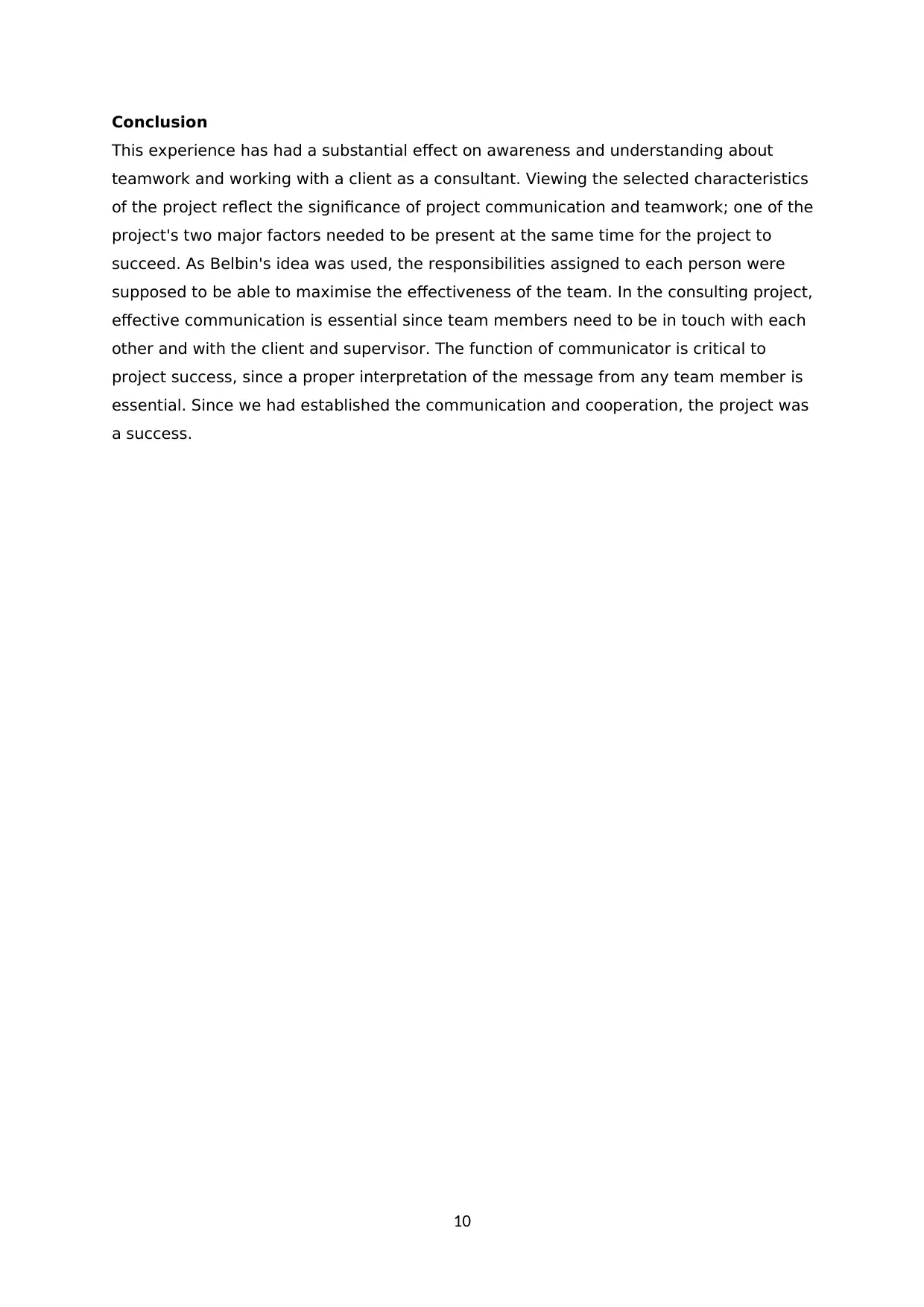
10
Conclusion
This experience has had a substantial effect on awareness and understanding about
teamwork and working with a client as a consultant. Viewing the selected characteristics
of the project reflect the significance of project communication and teamwork; one of the
project's two major factors needed to be present at the same time for the project to
succeed. As Belbin's idea was used, the responsibilities assigned to each person were
supposed to be able to maximise the effectiveness of the team. In the consulting project,
effective communication is essential since team members need to be in touch with each
other and with the client and supervisor. The function of communicator is critical to
project success, since a proper interpretation of the message from any team member is
essential. Since we had established the communication and cooperation, the project was
a success.
Conclusion
This experience has had a substantial effect on awareness and understanding about
teamwork and working with a client as a consultant. Viewing the selected characteristics
of the project reflect the significance of project communication and teamwork; one of the
project's two major factors needed to be present at the same time for the project to
succeed. As Belbin's idea was used, the responsibilities assigned to each person were
supposed to be able to maximise the effectiveness of the team. In the consulting project,
effective communication is essential since team members need to be in touch with each
other and with the client and supervisor. The function of communicator is critical to
project success, since a proper interpretation of the message from any team member is
essential. Since we had established the communication and cooperation, the project was
a success.
Paraphrase This Document
Need a fresh take? Get an instant paraphrase of this document with our AI Paraphraser
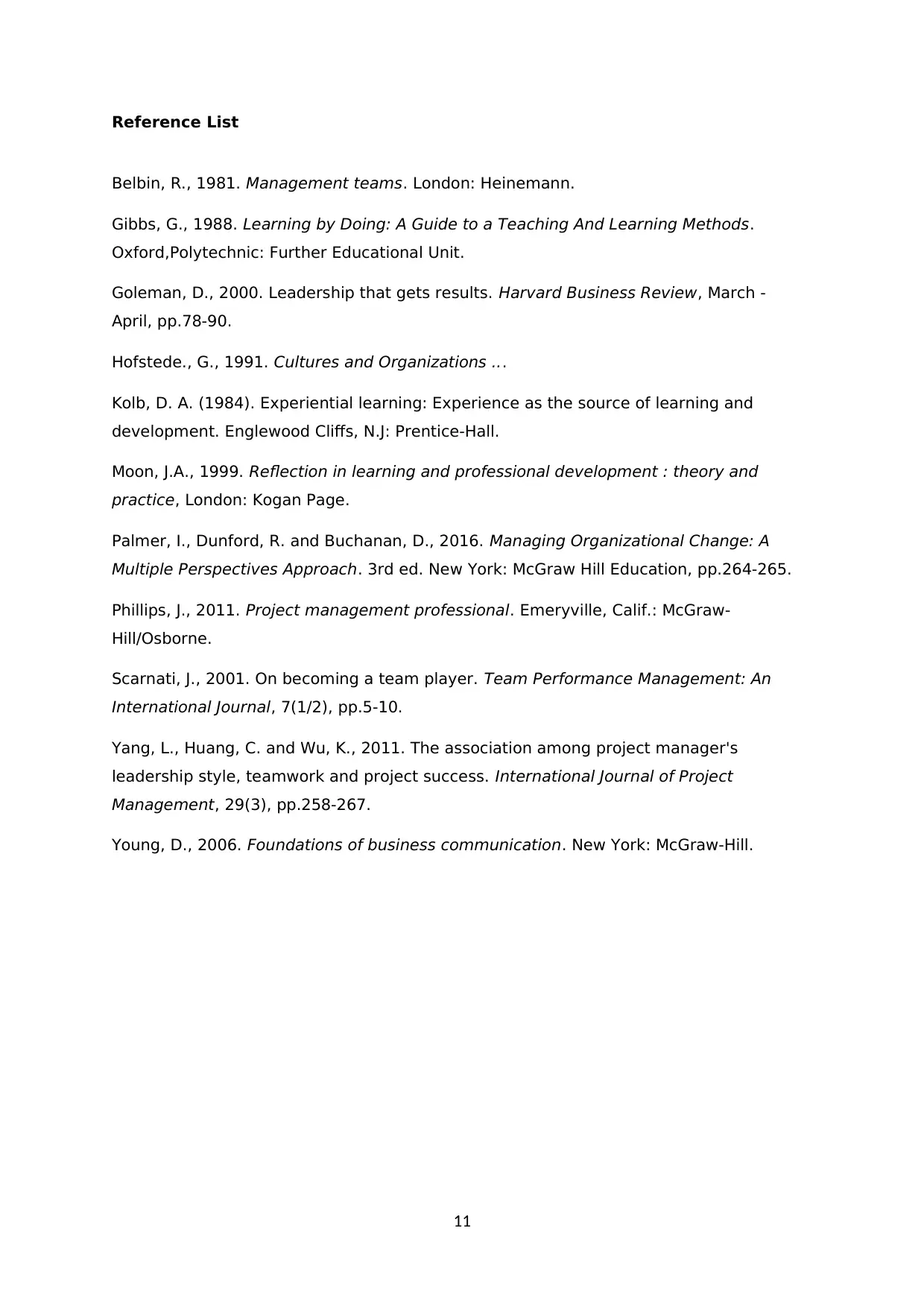
11
Reference List
Belbin, R., 1981. Management teams. London: Heinemann.
Gibbs, G., 1988. Learning by Doing: A Guide to a Teaching And Learning Methods.
Oxford,Polytechnic: Further Educational Unit.
Goleman, D., 2000. Leadership that gets results. Harvard Business Review, March -
April, pp.78-90.
Hofstede., G., 1991. Cultures and Organizations ...
Kolb, D. A. (1984). Experiential learning: Experience as the source of learning and
development. Englewood Cliffs, N.J: Prentice-Hall.
Moon, J.A., 1999. Reflection in learning and professional development : theory and
practice, London: Kogan Page.
Palmer, I., Dunford, R. and Buchanan, D., 2016. Managing Organizational Change: A
Multiple Perspectives Approach. 3rd ed. New York: McGraw Hill Education, pp.264-265.
Phillips, J., 2011. Project management professional. Emeryville, Calif.: McGraw-
Hill/Osborne.
Scarnati, J., 2001. On becoming a team player. Team Performance Management: An
International Journal, 7(1/2), pp.5-10.
Yang, L., Huang, C. and Wu, K., 2011. The association among project manager's
leadership style, teamwork and project success. International Journal of Project
Management, 29(3), pp.258-267.
Young, D., 2006. Foundations of business communication. New York: McGraw-Hill.
Reference List
Belbin, R., 1981. Management teams. London: Heinemann.
Gibbs, G., 1988. Learning by Doing: A Guide to a Teaching And Learning Methods.
Oxford,Polytechnic: Further Educational Unit.
Goleman, D., 2000. Leadership that gets results. Harvard Business Review, March -
April, pp.78-90.
Hofstede., G., 1991. Cultures and Organizations ...
Kolb, D. A. (1984). Experiential learning: Experience as the source of learning and
development. Englewood Cliffs, N.J: Prentice-Hall.
Moon, J.A., 1999. Reflection in learning and professional development : theory and
practice, London: Kogan Page.
Palmer, I., Dunford, R. and Buchanan, D., 2016. Managing Organizational Change: A
Multiple Perspectives Approach. 3rd ed. New York: McGraw Hill Education, pp.264-265.
Phillips, J., 2011. Project management professional. Emeryville, Calif.: McGraw-
Hill/Osborne.
Scarnati, J., 2001. On becoming a team player. Team Performance Management: An
International Journal, 7(1/2), pp.5-10.
Yang, L., Huang, C. and Wu, K., 2011. The association among project manager's
leadership style, teamwork and project success. International Journal of Project
Management, 29(3), pp.258-267.
Young, D., 2006. Foundations of business communication. New York: McGraw-Hill.
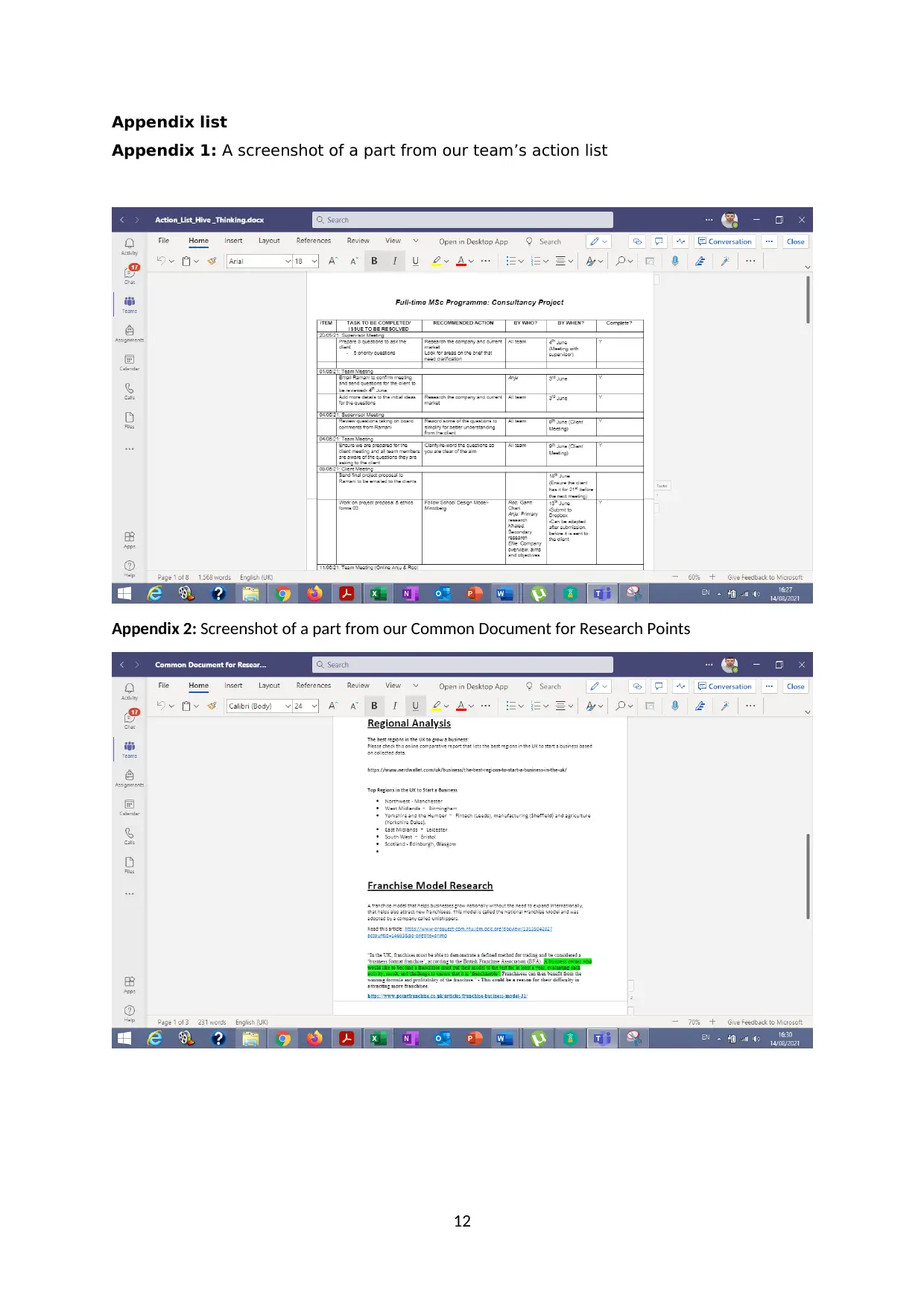
12
Appendix list
Appendix 1: A screenshot of a part from our team’s action list
Appendix 2: Screenshot of a part from our Common Document for Research Points
Appendix list
Appendix 1: A screenshot of a part from our team’s action list
Appendix 2: Screenshot of a part from our Common Document for Research Points
⊘ This is a preview!⊘
Do you want full access?
Subscribe today to unlock all pages.

Trusted by 1+ million students worldwide
1 out of 13
Related Documents
Your All-in-One AI-Powered Toolkit for Academic Success.
+13062052269
info@desklib.com
Available 24*7 on WhatsApp / Email
![[object Object]](/_next/static/media/star-bottom.7253800d.svg)
Unlock your academic potential
Copyright © 2020–2025 A2Z Services. All Rights Reserved. Developed and managed by ZUCOL.





